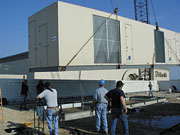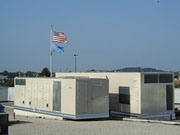

That's what makes the retrofit at Woodland Hills Mall in Tulsa, OK, so unique. When the mall's original rooftop units started to wear out, the exceptional operations director, John Saville, decided he wanted to replace them with the best equipment available. No off-the-shelf equipment for this project, said Saville, so custom-manufactured rooftop units were ordered.
Those rooftops would also have to include the many additional features that Saville deemed necessary for the mall. His goal? To design an HVAC system that would provide mall occupants an incredibly comfortable environment and the best IAQ, while offering mall management lower maintenance and energy costs and equipment that would probably outlive most of them. The result is an outstanding HVAC retrofit of which Saville is justifiably proud.

Initial Criteria
Woodland Hills Mall, rated as Oklahoma's number one mall, was built in 1975, then underwent an expansion that was finished in 1982. The completed mall required 22 rooftop units, providing about 1,700 tons of cooling, to keep occupants comfortable in its 1.1 million sq ft, and 165 retail stores. In late 2000, the rooftop units were between 20 and 25 years old and beginning to show their age."The units were very inefficient," said Saville. "A large part of our budget was tied up in maintenance expenses, keeping the units running, making repairs, replacing compressors, and fixing leaks. Those were some of the major problems. We needed new rooftops."
Saville consulted with two other people on his staff - the chief engineer and one of the HVAC technicians. Together they had combined experience of somewhere in the neighborhood of 75 years. The threesome first brainstormed about the various experiences they had and how they would like to see things done differently, then they came up with the criteria that would be used to select the replacement rooftops.
First, and foremost, the group decided that the changeover of equipment had to be done easily and quickly, without a lot of time spent reconfiguring pads and existing utilities. In addition, Saville wanted to make sure that the return and supply ducts would match up with the existing ductwork for every location on the roof.
"We also looked at the size of the units and whether there was an opportunity to increase capacity. When the units were originally sized, retail lighting loads were usually around 7 to 10 W/sq ft. That's no longer the case. For retail merchandising, we can see lighting loads of 31 W/sq ft, and the air conditioning equipment simply could not handle that kind of heat load," said Saville.
Another issue concerned IAQ. The mall simply wasn't able to meet ASHRAE standards for acceptable IAQ with its existing rooftop units. Although ASHRAE doesn't require shopping malls to have a minimum of 10% to 15% outside fresh air brought in, Saville wanted his mall to be a leader in the field.
Because of these criteria (as well as others), Saville knew that off-the-shelf rooftop units wouldn't work for the mall. He turned to custom manufacturer, Octagon Air Systems, located in Conley, GA for help.
The Wish List Grows
"John Saville was definitely the driving force behind the customization," said Todd Curlee, partner, Octagon Air Systems. "He's your atypical building owner. He knew so much about custom equipment and knew that's what he wanted. He convinced his people inside Urban Retail Properties (the former owners of the mall) at the mall level and at corporate level that this is what they needed to do."One of the big issues Saville was concerned with was having rooftop units that could handle the high ambient temperatures in Tulsa during the spring, summer, and fall. To accommodate these temperatures, Octagon designed the condensing section of the units to operate at 105 degrees F ambient and provide a maximum of 20 degrees condensing temperature at the 105 degree ambient.
"Most rooftop units are figured at about 99 degrees ambient for the condensers, so we raised that for our equipment. For every degree that you raise the condensing temperature, you increase your capacity," said Saville. Even though the physical tonnage of the new units wasn't much different than the existing units, they're actually larger due to that increased condenser capacity.
Saville also wanted screw compressors both for their reliability and their turndown capability. Because this is a VAV system, the turndown capability will keep tighter discharge control temperatures. The new compressors will also likely last at least 20 years with little maintenance.
In addition, Saville wanted two filtration systems in the rooftop units in order to provide better air quality in the retail space. "He wanted a filtration system that could handle the return air only, and then a separate filtration system that could handle both the outside air and the return air. Air quality is especially important during construction or build-out, because the air gets pulled back into the return and clogs the filters and just makes the unit very dirty. This was the best method for keeping the air cleaner for all the stores and retail shops during construction or tenant build-out," noted Curlee.
To further ensure superior IAQ, Saville wanted UVC lights to control mold and bacterial growth. "Long before September 11th, there was a scare of bacteria and viruses being spread. And we had some mold problems with the original air conditioners, so we decided we needed the UV lighting," said Saville.
Working with manufacturer's representative M/M Environmental Equipment Co., Saville specified Steril-Aire's "UVC Emitters(tm)" for installation in the custom air handlers. They are designed and manufactured to produce output greater than conventional UVC tubes in cold and moving air, so they can actually be installed just downstream of a cooling coil, which also encompasses the drain pan and other damp locations.
Here, the UVC energy cleanses the air and decontaminates the drain pan for improved IAQ. It also removes and prevents the formation of an organic primed biofilm that routinely builds up on the coil's entire cooling surface - a condition which, along with drain pan buildup, produces odors and causes efficiency, maintenance, and operational headaches.
Saville also decided he wanted refrigeration reheat capability to better control the humidity in certain parts of the mall, particularly areas containing fountains. And he also wanted a walk-in service vestibule inside each unit that could house all the compressors and VFDs, so that the service technicians could work on the units in inclement weather.
"Each vestibule has air conditioning, so it's like a little central plant. We also have fluorescent lights in every compartment, so we can work on the equipment at night," notes Saville.

How It All Went
Given that Saville's first criterion was to have a quick and easy retrofit, a tremendous amount of time was spent taking exact measurements of the curbs so the new rooftop units would meet up properly."Direct replacement is always challenging, matching the existing curb, the existing ducts, and the existing utilities exactly," said Curlee. "The added service vestibules meant we had to make the units a little larger than what we normally do, but everything still matched, it still fit, and we were within the weight constraints of the structure of the building."
Another reason why custom rooftop units were attractive to Saville was that they would be ready to be installed in a matter of weeks, rather than the approximately three months it would've taken with off-the-shelf units. Not to mention that the off-the-shelf units would have required more work in the field to match up with the existing curbs and ductwork.
"With our units, it was possible to take off an old unit and install a new one in a matter of hours," said Curlee. "They would usually start at 7 a.m. and rig two units a day. One of the requirements was that Octagon Air Systems had to staff the project with service techs to make sure at least one unit was operative by noon. Space temperature is extremely important in retail applications."
Saville set a schedule of 30 days in order to get the old rooftops removed and the new ones installed; however, they were able to get the job done in 18 days. "It was challenging, because we had a very tight schedule and at that time of year, you could have an evening thunderstorm pop up at any time. We always had the fear of having a large rooftop unit off, having large holes exposed, and having a major flood. Fortunately, we only had one thunderstorm, and we saw that one coming," said Saville.
And now that Saville has lived with his new HVAC equipment for two years, he couldn't be happier with the results. He says that with the UVC emitters, they have had zero mold growth, there are no algae deposits built up in condensate pans, and the air inside the mall smells better. As for energy costs, they were hit with a significant increase in the electrical fuel charge, but it's been estimated that the new rooftops are saving the mall about 15% in energy costs.
"I'm like a proud papa with my new system," said Saville. "My hat goes off to Octagon Air Systems for building a piece of equipment almost to the letter of the specifications that we asked for. And I'm thankful that the previous ownership allowed my staff and me to work with a degreed engineer to do something that probably most guys would only dream about doing." ES

The Mall In A Nutshell
The retrofits made to the HVAC system at the Woodland Hills Mall were extensive, including special attention to IAQ. Here is a brief fact sheet showing what was done and by whom:
- Manufacturer of custom rooftop air handlers: Octagon Air Systems.
- Description of air handlers: 22 single-zone VAV units with tonnage ranging from 50 to 110 tons each.
- Total tonnage of air handling system: 1,700 tons.
- HVAC installation general contractor: John Saville, Woodland Hills Mall.
- HVAC installation subcontractors: Tulsa Air Specialists; Temco Electric,; Allied Crane Rental.
- Manufacturer of UVC Emitters(tm) used in the custom air handlers: Steril-Aire, Inc.
- HVAC/UVC manufacturer's representative: M/M Environmental Equipment Co.
- Description of UVC equipment: High-output, double-ended Steril-Aire "UVC Emitters(tm)": 254 Emitters with 24 in. tubes, 8 with 18 in. tubes, and 4 with 30 in. tubes, for a total of 266 fixtures. The air handlers are also equipped with Steril-Aire radiometers (one per unit) to monitor UVC output.
Approximate cost of the retrofit: A little more than $3 million.
Other special features of the Octagon AHUs:
- Hitachi screw compressors;
- 105 degree ambient condenser design with a maximum 20? degree condensing TD;
- Welded tread plate flooring;
- Walk-in service vestibule;
- VFDs on centrifugal supply and return fans;
- "Double-filtering" system with separate return air and outdoor air filter sections;
- Service grating over duct openings;
- Refrigerant reheat capability for humidity control in many units;
- Electric preheat in many units;
- Motor and compressor removal hoist system;
- Johnson Controls Metasys(r) system; and
- Fluorescent lighting in all sections.

